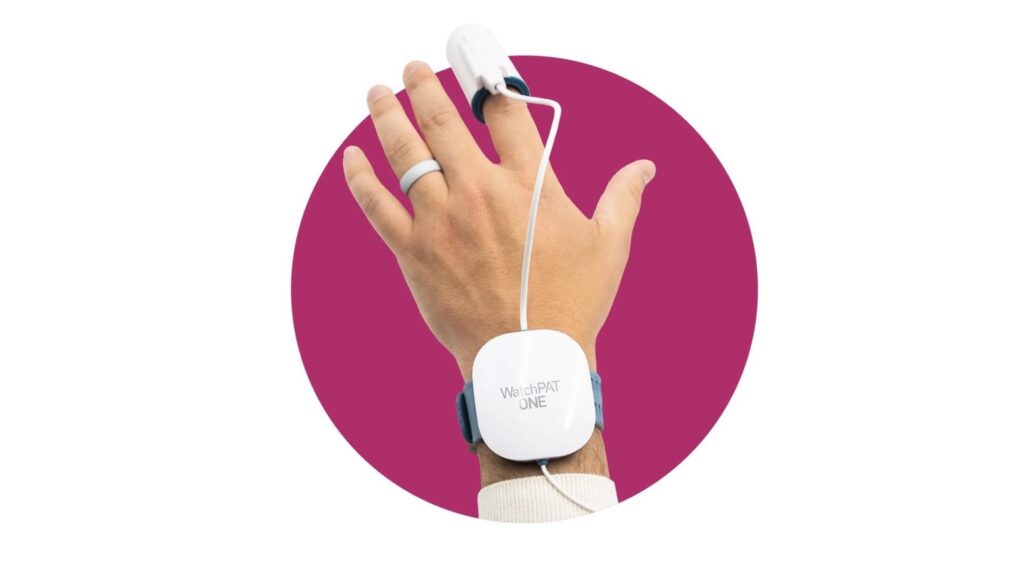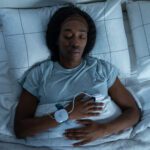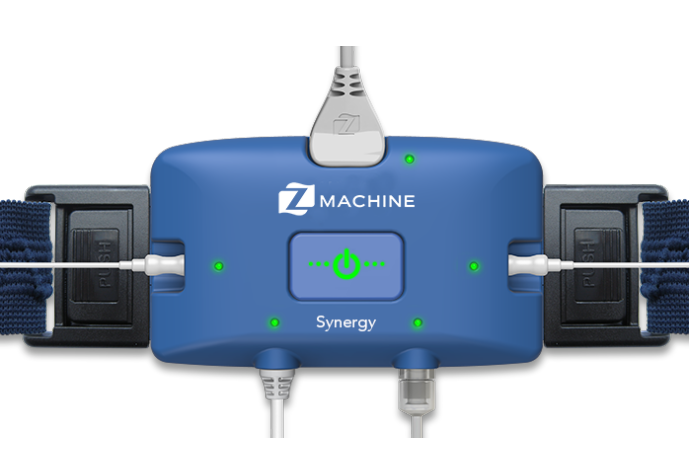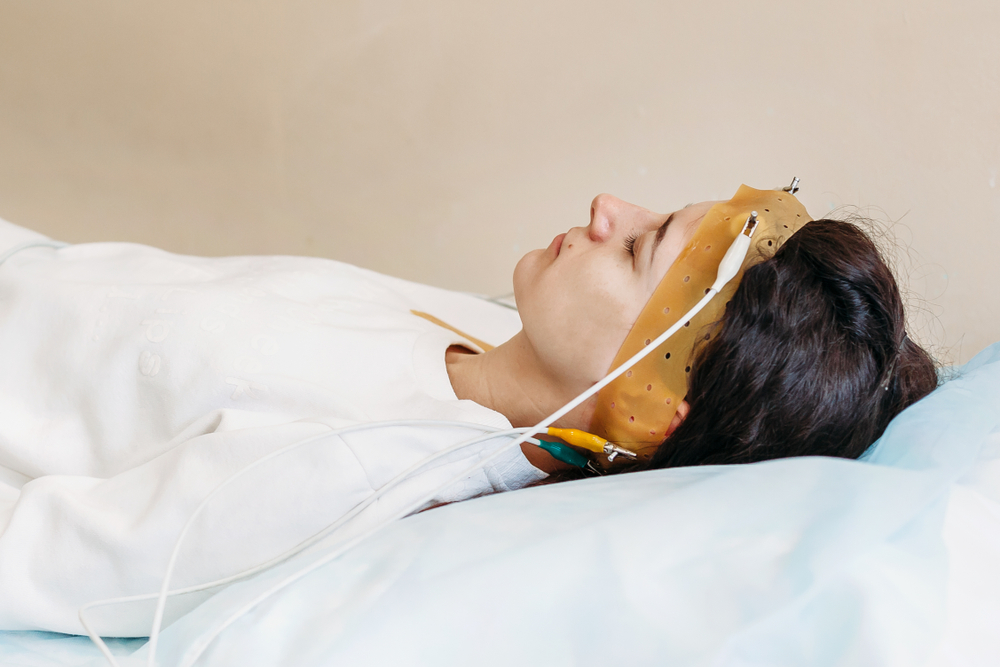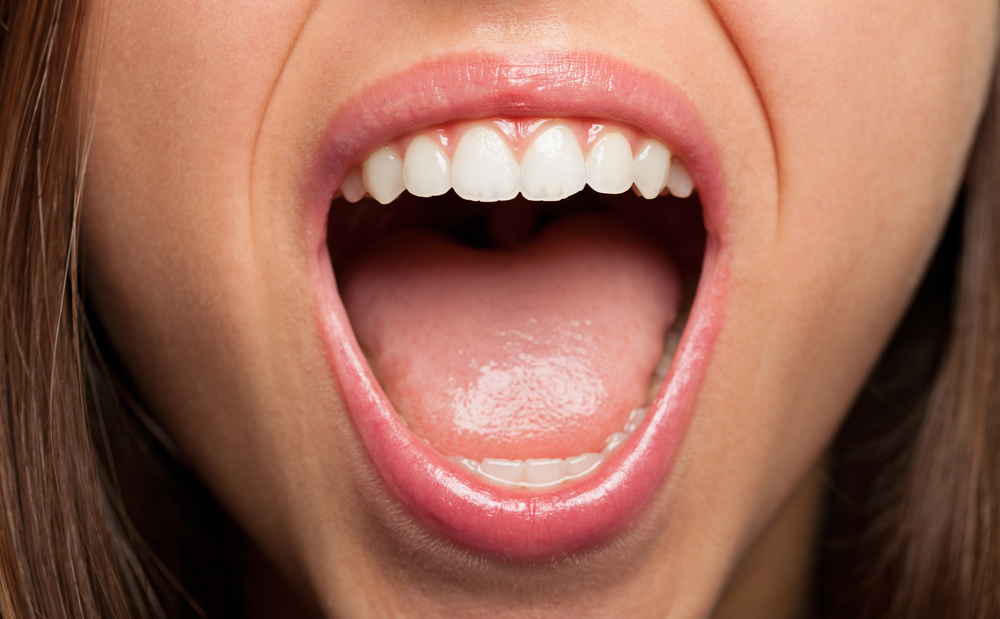Look & Feel
The test consists of two sensors connected by coated wires to a central sensor, which is worn on the wrist with an adjustable wristband. One sensor is worn on the fingertip, while the other is attached to the upper chest.
Ideal For
- Adults at least 18 years old who have symptoms of moderate to severe sleep apnea
- People who are reluctant to participate in a lab-based sleep study
- Those who find the cost of a sleep study prohibitive
Who should keep looking
- Anyone with a history of cardiovascular disease, stroke, or hypoventilation
- People who need to be assessed for sleep disorders beyond OSA or CSA
- People without access to a smartphone
-
Price
$349
-
Test Location
Wrist, finger, and neck
Obstructive sleep apnea (OSA) is a common sleep breathing disorder that can cause fragmented sleep due to periods of reduced airflow or pauses in breathing, and associated awakenings. Central sleep apnea (CSA) is a less common disorder with similar symptoms that’s caused by the brain briefly failing to send signals to the muscles that control breathing.
Diagnosing OSA or CSA usually requires an overnight sleep study. However, an at-home test like the Sleep Doctor WatchPAT ONE can be a more convenient and less expensive diagnosis option for some people. The WatchPAT ONE uses three sensors to monitor and record seven metrics that doctors use to diagnose OSA or CSA.
We’ll explain how the Sleep Doctor WatchPAT ONE works, how it differs from sleep studies and other at-home sleep apnea tests, and other information you should know when deciding whether this test is right for you.
What Is Obstructive Sleep Apnea (OSA)?
Obstructive sleep apnea is a sleep breathing disorder characterized by frequent periods when the sleeper’s airway is blocked, leading to a pause (or apnea) in their breathing. It is usually the result of relaxed muscles in the upper throat that cause soft tissues to block the airway.
OSA is the most common form of sleep apnea, but many people with sleep apnea do not realize they have the condition. Some common risk factors for OSA are alcoholism, being over 35 years old, and having a higher body mass index.
The apnea-hypopnea index (AHI) is a scale used to help diagnose OSA and determine its severity. A person’s AHI is the number of episodes of shallow or halted breathing they experience divided by the number of hours they slept.
Our Recommended At-Home Sleep Apnea Test

our partner at sleepdoctor.com
Save 54% on your Sleep Test Today
Shop Now“Wish I'd known how easy and affordable getting tested would be. Got my diagnosis fast, and now I'm actually getting decent sleep!”
Dawn G. – Sleep Doctor Customer
| OSA Severity | AHI Score |
|---|---|
| Mild OSA | 5-15 |
| Moderate OSA | 15-30 |
| Severe OSA | 30 or higher |
Signs and symptoms of OSA
Some symptoms of OSA occur during sleep, while others occur during waking hours. It may be worth speaking to your doctor about OSA if you experience:
- Excessive daytime sleepiness
- Dry mouth or headaches
- Inability to concentrate
- Sexual dysfunction
- Frequent nighttime awakenings
- Increased nighttime urination
Loud snoring that may sound like choking or gasping
How the WatchPAT ONE Detects Symptoms of Obstructive Sleep Apnea
The Sleep Doctor WatchPAT ONE uses three sensors — a wrist sensor, a pulse oximeter worn on the finger, and a chest sensor — to collect data on seven bodily metrics.
The data is sent via Bluetooth to an app on your smartphone, which transmits it to the cloud to allow your doctor to review these metrics for diagnosis. The information is also collected in a personalized sleep report. The device monitors the following metrics:
- Heart rate: A person’s heart rate slows during an apnea event, then increases after they begin breathing again.
- Blood oxygen level: Apnea events cause lower blood oxygen levels, which usually reach their lowest point as the sleeper begins to breathe again.
- Peripheral arterial tone (pulse volume changes): Changes in the volume of your pulse, also known as peripheral arterial tone, have been shown to correlate with OSA.
- Amount of snoring: How much a person snores may indicate the presence of OSA, in addition to helping determine its severity.
- Actigraphy (body movement): By monitoring body movement, actigraphy allows doctors to determine when the person being tested is asleep or awake.
- Chest movement: While people with OSA will attempt to inhale during an apnea event, people with CSA do not show this effort. Monitoring chest movement can help determine whether a person is experiencing OSA or CSA.
- Body positioning: A person’s sleeping position can sometimes directly influence the number of apnea events they experience.
Types of Sleep Apnea This Device Detects
The WatchPAT ONE is designed to detect both obstructive sleep apnea and central sleep apnea. People who believe they may have another sleep disorder — either instead of or in addition to sleep apnea — should speak to their doctor about an in-lab sleep study.
The WatchPAT ONE’s Accuracy at Detecting OSA Symptoms
At-home tests like the WatchPAT ONE can be an effective screening method for moderate to severe OSA and CSA. However, those experiencing milder symptoms may have better luck pinpointing their condition with an in-lab test.
If the results of the WatchPAT ONE are inconclusive or indicate possible symptoms of another sleep disorder, your doctor may recommend a follow-up sleep study at a sleep clinic.
How This Device Stacks Up Against Traditional Sleep Studies
Most cases of sleep apnea are diagnosed using a sleep study, or polysomnography, conducted at a sleep clinic. Some sleepers may be able to replace an in-lab sleep study with the WatchPAT ONE or a similar at-home testing device. However, it’s important to note that there are benefits and drawbacks to both types of testing.
WatchPAT ONE vs. In-Lab Sleep Studies
Some people are better suited to an in-lab sleep study due to their health or the possible presence of other sleep disorders. However, people who are otherwise good candidates for the WatchPAT ONE may choose one type of testing over the other based on reasons like cost, convenience, or accuracy.
| WatchPAT ONE | In-Lab Sleep Study | |
|---|---|---|
| Benefits |
|
|
| Limitations |
|
|
Does the WatchPAT ONE Replace a CPAP Titration Study?
The WatchPAT ONE transmits data to a licensed physician who reviews the information to diagnose your condition. If the doctor determines that you have OSA, they may recommend continuous positive airway pressure (CPAP) therapy.
Depending on the severity of your symptoms, they may also recommend a titration study, in which you try CPAP therapy in a lab setting to determine the appropriate fixed air pressure level. Once the right pressure setting is determined, you are given a prescription to purchase a CPAP machine.
Alternatively, the doctor may recommend automatic positive airway pressure (APAP) therapy and prescribe a pressure range. APAP machines automatically adjust pressure within the prescribed range based on your breathing patterns while you sleep.
What You Need to Know About the Sleep Doctor WatchPAT ONE
At-home sleep apnea tests like the Sleep Doctor WatchPAT ONE use sensors to track bodily metrics that your doctor then uses for a diagnosis.
Unlike some other at-home tests, the WatchPAT ONE tracks seven distinct metrics rather than relying on airflow alone. The test gathers data using a wrist sensor, a pulse oximeter worn on the fingertip, and a chest sensor.
What Comes With It
The WatchPAT ONE consists of a watch-like wristband that also houses the wrist sensor, as well as a pulse oximeter and a chest sensor. The pulse oximeter and chest sensor are connected to the wristband with coated wires.
Your product code provides access to the companion smartphone app, which controls the device, sends data to your doctor, and gives you access to your personalized sleep report.
While the WatchPAT ONE contains everything necessary to complete your test, medical tape may be useful for securing the chest sensor and ensuring it does not detach during sleep.
Components:
- Wristband with sensor
- Pulse oximeter
- Chest sensor
- Companion smartphone app
Technical Specifications
The WatchPAT ONE is named after its most notable feature, which is the use of proprietary peripheral arterial tone (PAT) technology to help diagnose sleep apnea. In addition to PAT, which tracks changes in pulse volume, the WatchPAT ONE measures six other bodily metrics.
One night of use should provide your doctor with the information needed to make a diagnosis, though a sleep period of less than two hours may require a second night of testing.
| Price: $349 |
|---|
| Features: Lightweight and noninvasive designThree sensors track seven bodily metricsUses proprietary PAT technology for increased diagnosis accuracyCompanion smartphone app provides access to the data collected and transmits it to your doctorDisposable design does not need to be returned to a clinic |
How to Use This Device
In addition to the testing night itself, using the Sleep Doctor WatchPAT ONE requires several steps before and after the test. It is crucial to watch and read all documentation provided with the WatchPAT ONE. User error can affect accuracy and may result in a follow-up sleep study being required.
- Step 1: After ordering the test, you will receive an email with directions and medical assessment forms. You should complete these forms as soon as possible to avoid potential delays.
- Step 2: Following the receipt of your assessment forms, you can book a video chat appointment with a licensed sleep doctor. The doctor will determine whether you are a candidate for testing using the WatchPAT ONE.
- Step 3: Setting up your WatchPAT ONE for a sleep test is a straightforward process, but familiarizing yourself with the instructions will help ensure accuracy. Since movement can knock the chest sensor out of place during sleep, many people find it helpful to secure the sensor with medical tape.
- Step 4: The WatchPAT ONE automatically relays data to your assigned doctor. One night of testing is sufficient for most people, although user error or a sleep period lasting less than two hours may require retesting.
- Step 5: After your test, you will receive your results, including an AHI score, via email. You will also be invited to make a second appointment with your assigned sleep doctor.
- Step 6: Your second appointment will include a discussion of your results and the opportunity to ask any remaining questions you might have. Your doctor will determine whether your results indicate a sleep apnea diagnosis and walk you through the next steps, including treatment options.
What Do Customers Have to Say About the WatchPAT ONE?
The Sleep Doctor WatchPAT ONE has generally received very positive reviews from customers. The device’s ease of use, cost-effectiveness, and rapid results are singled out by many reviewers as reasons why they are happy with their purchase.
Most complaints from customers center around technical issues with the companion app, as well as delays in shipping or results. However, responses recorded by the Better Business Bureau show that the company offers timely solutions for these complaints.
The majority of reviewers report that their test seemed highly accurate, though some report the opposite. While careful setup of the device can aid in accuracy, some people will require a follow-up in-lab sleep study if their results are inconclusive.
Warranty and Shipping Policies
| Availability | The WatchPAT ONE is available in a number of regions, including the U.S., Japan, and some European countries. U.S. customers can purchase the test through SleepDoctor.com, sleep specialist retailers, and third-party retailers such as Amazon. |
| Shipping | Shipping costs and times vary depending on which retailer you choose. Sleep Doctor provides free standard shipping on orders over $50. |
| Returns | Unopened tests purchased from Sleep Doctor can be returned within 60 days for a full refund, not including expedited shipping costs. Customers are responsible for the cost of return shipping. |
| Warranty | The WatchPAT ONE has a 12-month warranty covering material or workmanship defects. Depending on the issue, the device may be replaced or returned to the supplier for repair. Warranty claims should be made as soon as the defect becomes apparent. |
Medical Disclaimer: This content is for informational purposes and does not constitute medical advice. Please consult a health care provider prior to starting a new treatment or making changes to your treatment plan.
Still have questions?
Sleep apnea products can be confusing. If you need individualized assistance, send us an email at [email protected] with your questions and we'll help find the best fit for you.


